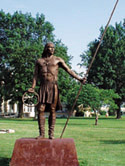|
|

Ben Johnson
photo by Andrew Campbell
|
|

Diné College in Tsaile, Ariz.
photo by Ed McCombs
|
|

A statue of an Apache stands on the campus
of Haskell Indian Nations University in Lawrence, Kan.
photo by Ben
Johnson
|
|
On the Trail of the Tribal Colleges
When senior history major Ben Johnson stepped onto the campus of the
Diné College in Tsaile, Ariz., in the middle of the huge Navajo
reservation, his first sight — sheep droppings — reminded him
how far he was from Northwestern. On the rolling college lawn nestled
in between rugged mountainsides, elderly Navajo women, known as "grazing
grannies," herded their sheep.
Johnson was impressed by the cooperation and understanding between the
college and the reservation community, a teamwork that clearly does not
exist at most universities. With the help of a research grant from Northwestern,
Johnson traveled last summer to Native American tribal colleges around
the country to compare these institutions with non–Native American
colleges and to study the rapid growth and unusual educational structure
at these reservation-based universities.
The American Indian Higher Education Consortium counts 32 tribal colleges
serving more than 24,000 undergraduates in the United States. Johnson
traveled to Arizona, Kansas, Montana, Nebraska and New Mexico to visit
five of the colleges. The schools, usually located in impoverished rural
communities, serve Native American youths and adults who want to further
their education but do not have the money or desire to leave their reservations.
One of the first places Johnson visited, Haskell Indian Nations University
in Lawrence, Kan., was not in a rural setting, of course, but it provided
a striking image from the past of the changes in relations between this
country and Native Americans. Founded in 1884, the college was originally
a U.S. government assimilation boarding school for Native American children
who studied under the slogan "Kill the Indian to Save the Man."
With the help of private donations, grants, government funds and industrial
backing, tribal colleges have been steadily growing in popularity since
their establishment in the late 1960s, and their campuses and course offerings
are improving greatly, Johnson says. He adds that these institutions of
higher learning not only provide opportunities for young people on reservations,
they also serve as focal points and gathering spots for the surrounding
reservation communities.
At Fort Peck Tribal College in Poplar, Mont., which Johnson also visited,
the school provides the Nakota and Dakota tribes with the Fort Peck reservation’s
main holistic health center where community members go for nutrition instruction
and exercise. And Diné College is the location of one of the Navajo
reservation’s main post offices.
Johnson found a high level of commitment among the professors and administrators
at tribal colleges to their students and to the schools’ relationship
with the communities.
Mona Bearskin, for example, dean of institutional advancement at Little
Priest Tribal College, which serves the Winnebago nation in Winnebago,
Neb., has a law degree and worked with two other lawyers a few years ago
to write the criminal and civil codes for the reservation.
"The people I met were committed to the tribal college movement,"
Johnson says. "But they also take the jobs because they really believe
in the importance of the college to the reservation. They have a real
caring for the community and a desire for something better."
One of the most compelling things about these schools, Johnson says, is
how much they are invested in tradition. At Diné College, the first
tribal college in the United States, which has several campuses in Arizona
and New Mexico, the mode of learning is based on the Navajos’ circular
"wedding basket" concept.
"Learning flows from nitsahakees (thinking) to nahata
(planning) to iina (living) to sihasin (assurance) and then
returns to thinking," Johnson says. "All the buildings on campus
are in the shape of the traditional eight-sided hogan [the Navajo
home], which is also based on the basket, and all the buildings are placed
spatially for meaning."
Classrooms are on the south side of Diné’s campus because
the south represents learning and reflection, and the sports fields are
on the north side because north is associated with physical activity and
hunting.
Dormitories are on the west side of the campus, where the home fire is
placed in a hogan, and the student union, or student orientation
center, is on the east side because hogan entrances traditionally
face east.
Despite the care that goes into providing a comfortably traditional learning
environment, there are still clear problems for students that stem from
the colleges’ locations off the beaten track. Many campuses were
so remote that Johnson frequently had to stay in hotels an hour-and-a-half
away and get up early in the morning to drive to the college.
"The main campuses most often are in a very rural setting to assist
in transmission of traditional values," Johnson says. "But students
in this setting have little to do on the weekends due to this remoteness."
Johnson expected the people he met would be cordial and accommodating,
but he was totally unprepared for the warmth that he received. He was
taken out for meals all the time and invited to pow-wow after pow-wow.
"The kindness I experienced was extraordinary: People took me out
to lunch and to their homes, and I got to meet their kids and grandkids,"
Johnson says.
Johnson is putting the information he gleaned directly into his senior
honor’s thesis in history and says the grants program has given him
precious insight.
"I gained firsthand access to important figures and ideas in the
tribal college movement and concrete visual images to shape my thinking,
as well as invaluable future contacts," Johnson says. "I feel
incredibly grateful for this opportunity to learn and travel in ways I
never anticipated when I came to Northwestern."
— E.R.
RETURN TO FEATURE STORY
|

